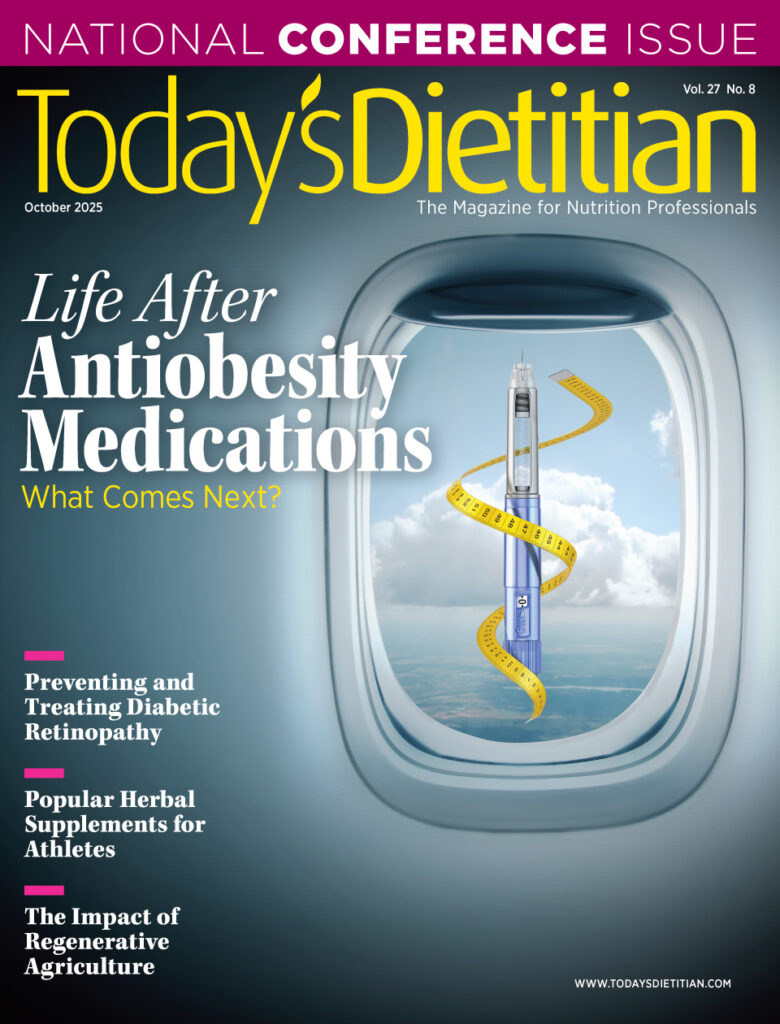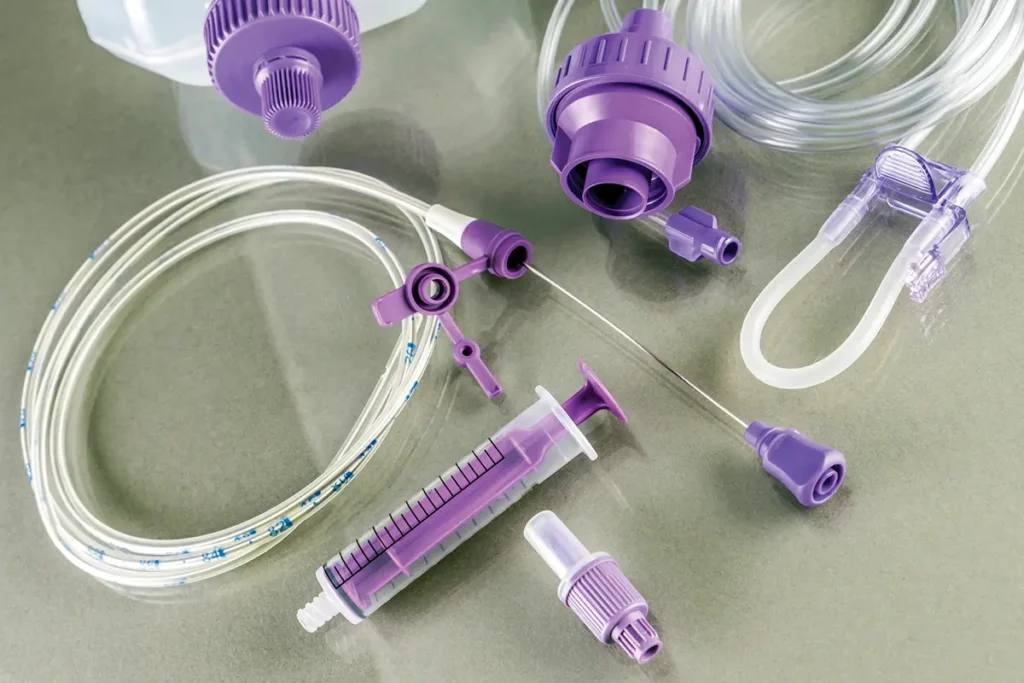Today’s Dietitian
Vol. 25 No. 3 P. 12
One of the fastest growing sectors in postacute care is the provision of home infusion pharmacy services from community pharmacies, specialized infusion companies, home health agencies, and hospitals.1 Notably, the home infusion pharmacy industry grew 300% from 2010 to 2020 due to the aging population and growing incidence of chronic diseases, complex new medications, and improved access to medical care for previously uninsured patients.2,3
Home infusion pharmacies offer several types of services to patients receiving postacute care, such as infusion therapies (eg, intravenous, subcutaneous, intrathecal, epidural), home health nursing, and home enteral nutrition (HEN).1 Dietitians, who traditionally provide MNT in hospitals and private care facilities, are at the forefront of HEN, working with interdisciplinary teams to help transition patients from the hospital to home to provide a continuum of care. The goal of the home infusion pharmacy is to provide quality care that enables patients to independently administer their medications and nutrition at home. Research shows that when patients take advantage of this opportunity, they can reduce medical costs, decrease risk of hospital-acquired infections, improve their quality of life, and experience better health outcomes.4 Specifically, receiving HEN enables patients with chronic conditions, such as swallowing difficulties, gastrointestinal disorders, or malnutrition, to optimize their nutrition status in a comfortable and familiar environment away from the hospital. Nutrition formulas are delivered via a small nasal bore tube, a gastrostomy tube, or a jejunostomy tube.
In this article, Today’s Dietitian explores the important role dietitians play in transitioning hospitalized patients requiring HEN, the intricacies and challenges involved in educating patients, their families, and caregivers, and strategies that potentially may lead to improved patient care and better health outcomes.
RDs’ Role
Home health care RDs play a pivotal role in helping patients requiring HEN to transition to the home setting. Much of the RD’s workflow is centered on education. During a typical workweek, dietitians may teach clinicians, patients, students, and medical residents how to infuse and manage HEN. They also teach patients’ families and caregivers. However, before RDs can begin to address teaching HEN, patients must be medically stable with an established nutrition feeding tube device and have a homegoing nutrition plan that has been approved by the inpatient provider teams.2 Patients also must tolerate enteral nutrition at or near the prescribed goal rate before RDs start teaching. If the teaching process begins too early during hospitalization, patients and their caregivers may become overwhelmed and discouraged, especially if they have to adjust to a change in medical stability or unforeseen tube feeding intolerances such as bloating or diarrhea. It’s important for RDs to take these issues into consideration and wait until a discharge plan has been developed before initiating a lesson on HEN. In addition, if RDs begin teaching before knowing the discharge plan, they could mistakenly educate patients about a continuous plan using a pump when the updated plan is to transition to a bolus feed.
Initial Meeting
Once the discharge plan is near completion, then it’s time for RDs to meet their patients and caregivers and begin building a rapport. During the initial meeting, RDs should discuss the process of HEN and how the home infusion pharmacy will deliver formula and supplies. RDs also should address all of the patient’s questions and concerns so on lesson day the primary focus will be learning how to infuse nutrition independently at home. It’s important for RDs to discuss the skills patients must learn during this initial visit and determine whether their home routine will be different from the hospital tube feeding set up. RDs should take the time to listen and answer patients’ housekeeping questions to help reduce stress and prepare them for a successful learning experience.
In addition, RDs will provide a written tube feeding instruction manual to patients so they have ample time to review it before their HEN lesson. Each manual is personalized to the patient’s homegoing tube feeding prescription. According to recommendations from the American Society for Parenteral and Enteral Nutrition, patient education should be written at a fifth or sixth grade reading level.5 The teaching manual is lengthy and details each step of tube feeding delivery using a pump, syringe, or gravity bag. When discussing the manual, RDs can begin assessing the patient’s and caregiver’s learning style preferences to help determine the best method for instruction. Patients may prefer written instructions or kinesthetic, hands-on demonstrations with a few interview questions.5 When possible, RDs should adjust the delivery of the lesson according to their patients’ preferred learning styles while still adhering to all necessary curricula.
Lesson Day
To prepare for lesson day after the initial visit, an interdisciplinary team, which includes a physician assistant, care manager, inpatient dietitian, and an infusion pharmacy liaison, work collaboratively in preparation for the lesson on HEN. Each team member assesses the patient’s medical stability and discharge readiness. If necessary, a global services interpreter is scheduled to attend the lesson if the patient doesn’t speak English.
RDs can bring a replica of the home tube feeding equipment as a teaching aid, which includes a feeding pump, a feeding bag set, syringes, formula, a feeding tube extension set, and the IV pole. While patients are in the hospital, both the formula and water flushes are delivered to them via the pump using a feed/flush system. At home, patients typically use a feed-only system, in which tube-feed formula is delivered via a pump, and water flushes are done manually using a syringe. When transitioning to a feed-only system, patients may feel tethered to their IV pole, but they can choose to convert this home setup to a mobile backpack system for convenience and travel. After RDs complete the HEN lesson, patients and/or caregivers must “teach-back” a safe demonstration of the HEN modality with limited verbal cues. This teach-back is important for patients to develop more confidence, and it demonstrates the efficacy of the RD’s teaching and overall lesson.
Challenges to Teaching HEN
While this process, as discussed, may appear seamless, there are challenges RDs may encounter when preparing and teaching HEN lessons. Patients may be unable to grasp new concepts if the RD doesn’t present the information clearly or if it’s not tailored to their health literacy level. Making an assessment of a patient’s health literacy can be difficult, but it’s essential to tailor the lesson to his or her needs. Health literacy is impacted by patients’ reading comprehension, and their ability to incorporate information and handle life stressors. Health care inequities and limited access to health care resources can negatively impact a patient’s ability to safely carry out HEN instructions. Moreover, all patients, regardless of their education, are at risk of misunderstanding health information. Misconceptions can be exacerbated if the information is emotionally charged or perceived as overwhelming.
In addition, the generational differences among patients can impact the efficacy of HEN lessons. Traditionalist learners frequently require multiple sessions before they return home. Traditionalist learners tend to resist change and fear developing a new set of skills they’ll have to practice independently. These learners often require teaching to be split into shorter, more manageable sessions so they can ease into the tube feeding process and gain confidence. On the other hand, younger learners often already have familiarized themselves with HEN by reading about the process online, watching YouTube videos, and listening to podcasts before meeting with an RD. This background knowledge can be helpful, but it also can give these learners a false sense of confidence. It’s essential to complete the curriculum in its entirety for every patient, independent of learning styles.
Another issue RDs may face is a patient’s resistance or refusal to take part in the HEN learning process. If this occurs, it’s best to reschedule the lesson for the following day unless there’s a caregiver available who’s willing to cooperate. Ultimately, patients have the autonomy to make their own health decisions. If a patient refuses instruction and there are no available caregivers, the team will have to create a new discharge plan that accounts for these safety concerns.
Once patients are ready for discharge, home care RDs provide their contact information in case patients require feeding pump troubleshooting, tube feeding supplies, or have any follow-up questions. On occasion, home care nurses will contact RDs to assist with enteral nutrition questions or clarifications about the tube feeding orders. Within seven days of discharge, the home care RD reviews the patient’s EMR for health updates or changes. If the patient still is on tube feeds after 30 days, a home infusion nurse or dietitian will follow up with the patient or caregiver. If a new nutrition assessment or change in tube feeding formula is needed, a virtual or individual nutrition consult will be arranged with the outpatient nutrition department.
Poised for Service
Home health RDs are uniquely suited to provide HEN education in the inpatient setting. When HEN teaching and teachbacks occur before discharge, patients and caregivers have the opportunity to become more confident and empowered to execute tube feedings at home. The RD’s role is to add coordination of care and nutrition support throughout the transition to home and is considered an asset to the home infusion pharmacy team. Pharmacists rely on RDs for coordination and understanding of the enteral nutrition order. Health care is ever-evolving, and RDs make a significant contribution to the overall nutritional well-being of their patients by guiding their safe transition back home.
— Berri Burns, MEd, RD, LD, CNSC, is an advanced practice dietitian at Infusion Pharmacy at Home at Cleveland Clinic in Ohio.
References
1. Petroff BJ, Filibeck D, Nowobilski-Vasilios A, Olsen RS, Rollins CJ, Johnson C. ASHP guidelines on home infusion pharmacy services. Am J Health Syst Pharm. 2014;71(4):325-341.
2. NHIF infusion industry trends report. National Home Infusion Foundation website. https://nhia.org/nhif/nhif_infusion_industry_trends_report. Accessed December 10, 2022.
3. Wright B. The growing home infusion industry. HomeCare website. https://www.homecaremag.com/operations-strategies-home-infusion/november-2016/growing-home-infusion-industry. Published December 5, 2016.
4. 4 benefits to home infusion therapy. Amber Specialty Pharmacy website. https://www.amberpharmacy.com/4-benefits-to-home-infusion-therapy. Published October 10, 2018.
5. Mueller CM, ed. The ASPEN Adult Nutrition Support Core Curriculum. 3rd ed. Silver Spring, MD: American Society for Parenteral and Enteral Nutrition; 2017.
Resources
• American Society for Parenteral and Enteral Nutrition (www.nutritioncare.org)
• The ASPEN Adult Nutrition Support Core Curriculum, 3rd Edition (https://portal.nutritioncare.org/bookstore-details?id=499140f5-27c8-431db1db-fe504e27a42d&reload=timezone)
• Academy of Nutrition and Dietetics (eatright.org)
• Handbook of Home Nutrition Support by Carol S. Ireton-Jones, PhD, RD, LD, CNSC, FACN, and Mark H. DeLegge, MD, FACG, AGAF, FASGE (https://books.google.com/books/about/Handbook_of_Home_Nutrition_Support.html?id=KtSF221KP-0C)
• Adult Short Bowel Syndrome: Nutritional, Medical, and Surgical Management by Mandy L. Corrigan, MPH, RD, CNSC, FAND; Kristen Roberts, PhD, RDN; and Ezra Steiger, MD, FACS, FASPEN (www.amazon.com/Adult-Short-Bowel-Syndrome-Nutritional/dp/0128143304)
• Advanced Nutrition and Dietetics in Nutrition Support by Mary Hickson, PhD, RD; Sara Smith, PhD, RD; and Kevin Whelan, PhD, RD, FBDA (https://onlinelibrary.wiley.com/doi/book/10.1002/9781118993880)
• The Art and Science of Patient Education for Health Literacy by Melissa N. Stewart, DNP, RN, CPE (Available on Amazon.com and ElsevierHealth.com)
• The Oley Foundation (https://oley.org)
• Global Enteral Device Supplier Association (https://stayconnected.org/enfit)
Skills Checklist for Home Care and Infusion Pharmacy RDs
• Knowledge and expertise in a vast variety of enteral tube feeding formulas
• Knowledge and experience with commercial and blenderized formulas
• Working hands-on knowledge of tube feeding pumps operations/troubleshooting
• Understanding and hands-on experience with bolus or gravity feeding delivery methods
• Maintaining a working knowledge of product recalls and shortages
• Detailed understanding of equipment changes related to legacy or ENFit connections
• Learning how to react to payer changes and reimbursement challenges
• Assisting home infusion pharmacy to provide adequate but not excessive supplies
• Become proficient in The ASPEN Adult Nutrition Support Core Curriculum• Certified Nutrition Support Clinician credentialing



